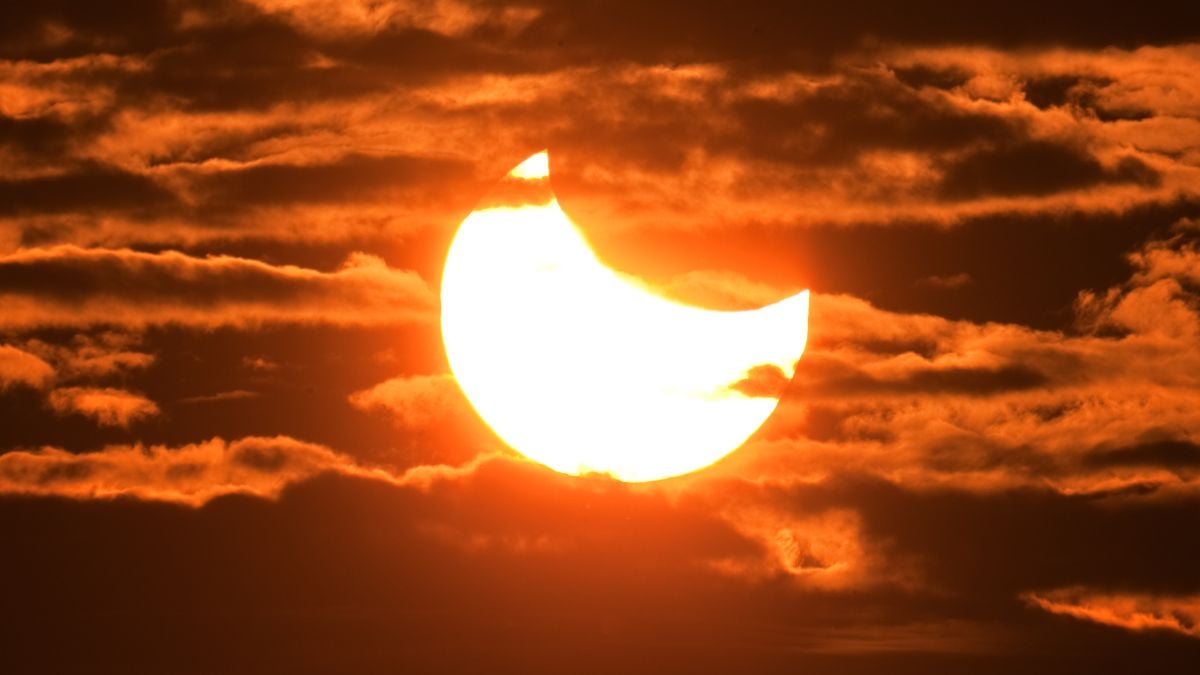
Where and at what time is the solar eclipse on March 29, 2025? As this phenomenon approaches—one of the most anticipated astronomical events of the year—Google searches on the topic are beginning to surge.
Although it won’t be a total solar eclipse, this event will be a fascinating natural spectacle visible in several cities across the Americas, and it will also be broadcast live via NASA’s streaming platform.
What time does the March 2025 solar eclipse start in the Americas?
The American continent will be one of the lucky regions, especially the northeastern part, where several U.S. cities will have a privileged view of the eclipse right at sunrise. Here’s the full list with precise times and maximum solar coverage percentages:
- Baltimore, Maryland: Start: 6:55 a.m., Maximum: 6:57 a.m. (3% coverage), End: 7:02 a.m.
- Boston, Massachusetts: Start: 6:31 a.m., Maximum: 6:38 a.m. (43% coverage), End: 7:07 a.m.
- Buffalo, New York: Start: 7:02 a.m., Maximum: 7:05 a.m. (2% coverage), End: 7:09 a.m.
- New York, New York: Start: 6:44 a.m., Maximum: 6:46 a.m. (22% coverage), End: 7:04 a.m.
- Philadelphia, Pennsylvania: Start: 6:49 a.m., Maximum: 6:51 a.m. (12% coverage), End: 7:03 a.m.
- Portland, Maine: Start: 6:27 a.m., Maximum: 6:30 a.m. (64% coverage), End: 7:10 a.m.
- Washington D.C.: Start: 6:56 a.m., Maximum: 6:59 a.m. (1% coverage), End: 7:01 a.m.
- Paramaribo, Suriname: Start: 6:40 a.m., Maximum: 6:42 a.m. (1% coverage), End: 6:47 a.m.
Solar eclipse time in some European cities
In Europe—specifically in Madrid, Spain—the eclipse will begin at 10:48 a.m., reach its peak at 11:40 a.m. with 21% coverage, and end at 12:33 p.m.
It will also be clearly visible in much of Greenland, Iceland, northern Asia, regions of western and northern Africa, as well as in wide areas of the Atlantic and Arctic Oceans.
- Madrid, Spain: Maximum point at 11:40 a.m. (local time).
- Lisbon, Portugal: Maximum point at 10:31 a.m. (local time).
- London, United Kingdom: Maximum point at 11:03 a.m. (local time).
- Berlin, Germany: Maximum point at 12:19 p.m. (local time).
- Reykjavík, Iceland: Maximum point at 11:05 a.m. (local time).
- Dublin, Ireland: Maximum point at 11:00 a.m. (local time).
What is the solar eclipse of March 29, 2025?
The solar eclipse of March 29, 2025 is an astronomical phenomenon in which the Moon will pass between the Earth and the Sun, partially covering the sunlight in various regions of the world. According to NASA data, this phenomenon will begin exactly at 8:50 UTC and end at 12:43 UTC.
Unlike a total solar eclipse, where the Moon completely blocks sunlight, this will be a partial solar eclipse—only part of the Sun will be covered by the lunar disk.
Will the March 2025 solar eclipse be visible in Mexico?
No, the March 29, 2025 solar eclipse will not be visible in Mexico, but enthusiasts can follow it through official broadcasts on platforms such as NASA’s.
ALSO READ: What is the net worth of Marvin Sapp, the pastor and singer who demanded his congregation donate $40,000?
How to watch the solar eclipse safely
Watching a partial solar eclipse requires specific precautions to protect your eyes. According to NASA, looking directly at the Sun during a partial eclipse can cause permanent vision damage. To observe this phenomenon safely, the following is recommended:
- Use certified solar eclipse glasses (ISO 12312-2).
- Never use regular sunglasses, as they do not provide adequate protection.
- Avoid looking directly at the eclipse through telescopes, binoculars, or cameras without special solar filters.
If you don’t have special glasses, you can view the eclipse using indirect methods such as projecting it with a pinhole card (pinhole projector), or using the natural shadow cast by tree leaves.
Will there be a live broadcast of the March 29, 2025 solar eclipse?
For those unable to watch the eclipse in person, NASA and various international astronomical organizations will broadcast the event live from several strategic locations. These streams will allow viewers to enjoy the phenomenon from unique perspectives, including through specialized telescopes.
Get ready to enjoy the March 29, 2025 solar eclipse—an astronomical show that promises to captivate global attention and provide an unforgettable visual experience, as long as you follow the recommended safety guidelines.
⇒ WE INVITE YOU TO FOLLOW US ON GOOGLE NEWS









